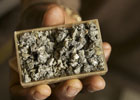
A meeting of international delegates working to prevent the trade in blood diamonds recently ended a review of Zimbabwe’s abuse-ridden diamond trade in deadlock. After 10 years in existence, the Kimberley Process, a certification scheme set up to combat the diamond trade that was helping finance some of Africa’s most brutal wars, is at a crossroads, and some critics have warned of the “return of the blood diamond.”
Some of the pitfalls of the Kimberley Process were on display, generating some clear lessons for creating a system for certifying Congo’s conflict minerals, the 3Ts and gold.
The key question on the table at the meeting of member states was whether to certify Zimbabwe’s diamonds as conflict free. After all, the Kimberley Process, or KP, was designed to prevent armed rebel groups from using diamond exploits to fund rebel groups against legitimate governments. But in Zimbabwe, it’s the government that is cited for abuses including the killing of 200 civilians at Chiadzwa in a population-clearing operation by the army and militarizing the entire diamond region of Marange, which was previously peaceful. The Tel Aviv meeting broke up without making a firm decision on Zimbabwe; the group will reconvene in Jerusalem later this month.
While some see this as positive because Zimbabwe’s diamonds are still not certified as conflict free, the Kimberley Process will have to deal with this issue somehow. With the current stalemate, what lessons should be applied to ensure that other minerals from resource-rich eastern Congo – even more ubiquitous than diamonds since they power our electronic devices – don’t perpetuate conflict?
I recently spoke to Bernard Taylor, executive director of Partnership Africa Canada, an organization that was integral in establishing the Kimberley Process. Partnership Africa Canada was nominated for a Nobel Peace Prize in 2003 for its research on blood diamonds and contribution to founding of the Kimberley Process. Taylor offered some recommendations (in no particular order) for regulating the conflict minerals trade in Africa’s Great Lakes region:
Auditors should be independent. While the Kimberley Process has a peer review system, it is “less than satisfactory,” according to Taylor, and there is no independent auditing team that regularly investigates potential loopholes in the system. In particularly questionable cases only, a revolving ad hoc team from three or four member states, accompanied by representatives from the diamond industry and civil society, visits diamond production sites to conduct assessments. In theory, it’s a collaborative process where the substantive work is shared among KP member states.
The problem is that these teams are susceptible to commercial and political interests. “When you come down to choose, do you want something like the KP system, or one that’s professional and independent, where professional auditors are trained and specializing in this area of work?” Taylor rhetorically asked.
The administrative body should be permanent. The KP’s secretariat revolves among member states, so institutional memory is lost from year to year. “We go from a strong leadership, to weak leadership, to indifferent leadership, to bad leadership – it’s a yoyo system,” Taylor pointed out.
Certification system should be designed to be flexible and able to adapt to new challenges. Unforeseen challenges will inevitably arise, especially as the offenders find ways to exploit weaknesses in the established system. For instance, the KP’s original strict focus on abuses committed by rebel groups has hamstrung the group when presented with state-sponsored violence, such as the case of Zimbabwe. But as it stands, all actors – member states, diamond industry, and civil society – must unanimously agree upon the decisions made by the Kimberley Process, so the lowest common denominator prevails. Critics cite this consensus requirement as a downside. As Taylor pointed out, in Africa’s Great Lakes, all of the regional governments have to see that the system is in their own best interest; if one government does not follow through on commitments, the gap would cause the whole system to break down because minerals could be smuggled out through that recalcitrant country. But the bottom line, according to Taylor, is that the system “must not be set in stone.”
First monitoring point must be as close as possible to the mine. Even stringent and consistent controls in the subsequent countries have little value if the supply chain is potentially contaminated at the origin.
Mineral production areas should be free of military activity. It may seem like an obvious point, but the fact that the Kimberley Process didn’t mandate that soldiers not be present is again an effect of its narrow focus on blocking rebel groups. Of course, because it didn’t anticipate that government forces could itself be the predator, an abusive environment like Zimbabwe’s was able to arise. Certainly in the context of eastern Congo, where the national army is notoriously undisciplined and opportunistic, requiring soldiers to clear out of mining areas would be crucial.
The good news is that many of the lessons learned from the Kimberley Process are being heeded in the initial plans for dealing with conflict minerals from eastern Congo. Taylor’s Partnership Africa Canada and others who were intimately involved in setting up the Kimberley Process are advising the governments and civil society groups designing the tracking and certification system for Africa’s Great Lakes region.
However, as Taylor pointed out, political will and ability among central Africa’s governments are likely hurdles once the system is ready to roll out. Furthermore, the minerals trade is just one element of the conflict in eastern Congo, and parallel initiatives to address other tensions must be undertaken. To emphasize his point, Taylor mentioned one of the region’s most brutal rebel groups, whose leadership was responsible for the 1994 genocide in neighboring Rwanda. “This [certification] system is not going to disarm the FDLR, but it will stop them from getting all that they had in the past,” Taylor said. “Anyway, you can have the best of intentions, but if people are shooting at you, what can you do?”
Photo: Tin ore in eastern Congo (Sasha Lezhnev)

